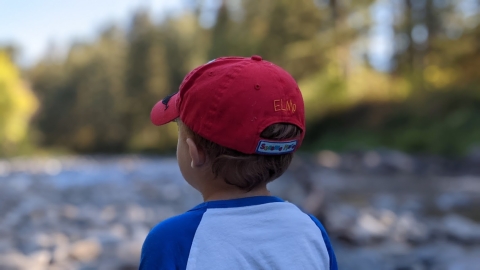By Juliette Fernandez, refuge manager at Ridgefield National Wildlife Refuge Complex.
As we walked down the sidewalk in front of our house, I picked up a pine cone and handed it to my 4-year-old son. “Look,” I said, “Douglas is waving at you from inside this pine cone!”
My son looked at the pine cone and I showed him the tiny hand-shaped bracts that peek out from the scales of the pine cone. “This pine cone is from a tree called a Douglas fir. You can always remember that if you pretend a little elf named Douglas is waiving at you from inside the pine cone.”
My son is now obsessed with finding Douglas fir pine cones.
I am a wildlife biologist by degree, and a national wildlife refuge national wildlife refuge
A national wildlife refuge is typically a contiguous area of land and water managed by the U.S. Fish and Wildlife Service for the conservation and, where appropriate, restoration of fish, wildlife and plant resources and their habitats for the benefit of present and future generations of Americans.
Learn more about national wildlife refuge manager by title. But really, I’m just a mom who loves bugs and sticks, and doing stuff with my kid. Long before I knew about national wildlife refuges, I was a kid growing up in the Sonoran desert. I just preferred to be outside. We didn’t have refuges or national parks … or even city parks where I grew up.
I grew up in the desert of Arizona; the hot, dry, stickered, snaky, rugged, fantastic desert. I had a small patch of grass that bristled in the summer heat under a big ash tree. I had a rock garden and, despite how it may sound to the lush dreamland that is the Pacific Northwest, there was quite a world of wonder right under my nose.
I remember laying on my warm driveway just looking at what came about. I marveled at the unique intricacies of the horse lubber, and the fervent mission of the ant. I’d lift rocks to find roly-poly bugs and watch them walk up and down my hand before returning them to the cool soil under their quartz castle. I’d catch horned toads, and we would blink at each other for a few minutes before I returned the tiny dinosaurs to their sunny gravel. These mini moments with these mini beings were my mini refuges.
I was curious. I learned, and I loved.
These days, I might not be up for a grand adventure with my son every weekend. So we walk outside and I very gently move an inch of mulch in the backyard, and we find kingdoms of earthworms to learn from. Their kingdoms are painted with roots, and soil, and sometimes, roly-polies. They walk on our hands. We talk about what they are doing, how it tickles our hands, and how they’d like to go back home. We wish them well before tucking them back into the mulch.
We close our eyes and count on our fingers how many different sounds we hear. It could be a bird, the scurry of a squirrel, or the wind in the trees. This is the music of nature, and you can always hear her symphony. Together we mimic the bird call, we run like a squirrel, and we stretch like a tree in the wind.
From the bottom of my heart, I love national wildlife refuges. I love conserving plants and animals, and sharing that love with visitors. Still, I recognize that not every child in every neighborhood has a refuge … at least not an official one.
Step outside and you will see the amazing world brings nature to you in every step. Look in your yard. If you don’t see anything right away, look closer, then closer, then closer. Do you see new mini worlds? Take a moment just to be curious, to learn and to love.
Originally written by Juliette Fernandez for the Lower Columbia Nature Network





